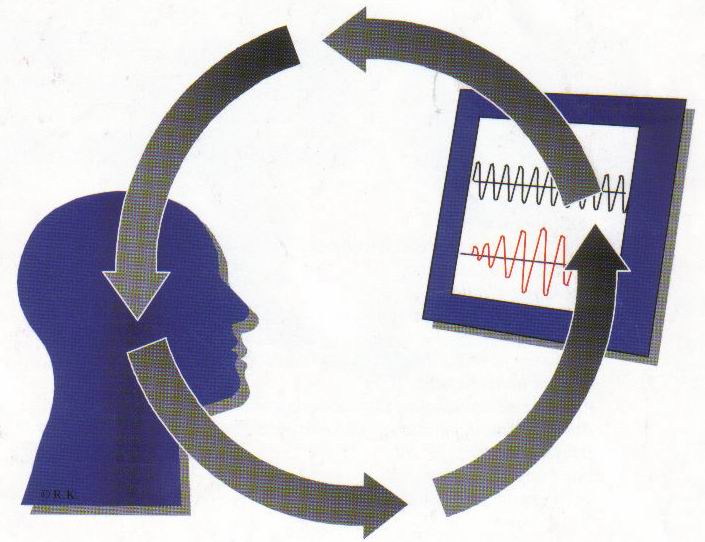- Home
- 7 Steps of Goal Setting
- Biofeedback Techniques
Biofeedback Techniques for Stress Relief
Biofeedback techniques enable you to harness the power of your mind combined with technology to reduce stress. Biofeedback machines provide you with real-time feedback of your biological processes that you use to train the mind-body connection.
Biofeedback works by giving you feedback on various physiological functions that you may not be aware of, including skin temperature, muscle tension, and/or brain waves.By becoming more aware of the subtle body changes that occur when you are stressed allows you to develop strategies to control them. Being more aware of the changes in your biological processes gives you more control of how stress affects you.
The four biofeedback techniques that I use with clients are:
- temperature biofeedback
- galvonic skin response
- electromyogram (EMG) biofeedback
- electroencephalogram (EEG) biofeedback
Here I discuss the different biofeedback techniques and how it works for stress relief...
How biofeedback works for stress relief
There are two reasons why biofeedback is important for your stress management.
- Not all forms of stress are noticeable. Over time we adapt to everyday stressors - work pressure, daily hassles, relationship stress, or overwhelming responsibilities. We treat these causes of stress as an inevitable part of living. But you could be living with an unhealthy amount of stress! Stress creates wear and tear on your body with the subtle changes in your body going unheeded. Biofeedback raises our awareness to make changes to reduce stress.
- You learn to harness the power of your mind to control your biological processes in response to stress. Using advances in technology, psychology, and physiology allows you to observe and then master subtle body changes to cope with stress.
Temperature or thermal biofeedback
Temperature biofeedback, also called thermal biofeedback, monitors skin temperature. A thermistor on a finger monitors the change in your skin temperature. When the fight or flight response is activated, a common stress symptom is that your skin temperature drops.
As blood is shunted to major muscle groups that may be needed to flee or fight, the temperature in your extremities (namely your hands and feet) drops. Temperature biofeedback techniques inform you of the skin temperature in your hand - this may be monitored and one is able to train one to control it.
Temperature or thermal biofeedback has been found to be useful in treating migraine headaches and Raynaud's phenomenon.
Electromyogram (EMG) biofeedback
Have you ever noticed increased tightness in your shoulders and neck after a hard day's work? Do you get tension headaches and/or notice that the muscles around your jaw get tense when you are stressed?
An electromyogram (EMG) biofeedback machine measures the electrical activity in your muscles. An EMG biofeedback machine provides feedback on the tension in your muscles via electrodes placed on your skin over the particular muscle group. The more tense your muscles the greater the electrical activity.
The EMG biofeedback machine provides its feedback on a digital display and/or through an auditory signal such as clicking sounds. You are able to recognize muscular tension early by the use of EMG biofeedback on a regular basis. But, more importantly, you learn to relax your tense muscles for stress relief.
|
Electroencephalogram (EEG) biofeedback
I have used electroencephalogram (EEG) biofeedback with students at university to highlight the power of relaxation techniques to alter brain waves. Students are often amazed at how they can train themselves to influence their brain waves and achieve alpha state.
EEG biofeedback (nuerofeedback) involves placing electrodes on your head and monitoring your brain waves. You learn to change your brain waves to alpha waves, characterized by increased relaxation and calmness, with various relaxation techniques such as breathing techniques.
When I use EEG biofeedback I place two electrodes on either side of the forehead and one on the inion (back of the head). Through software and biofeedback games it is possible to monitor and train yourself to achieve a relaxed and calm state.
EEG biofeedback is used for anxiety disorders, stress, depression, insomnia and chronic pain.
Galvanic Skin Response (GSR) biofeedback
When stressed, your body secretes more sweat in anticipation of fighting or fleeing from the stressful situation.
This increased sweat gland activity (usually invisible to the eye) increases your body's skin conductance and electrical activity.
Galvanic skin response (GSR) biofeedback detects these changes in electrical current and is recorded digitally or by an auditory signal. GSR biofeedback has been helpful in monitoring and controlling stress, hypertension, anxiety, and stuttering.
If you liked biofeedback techniques then you may be interested in the definition of stress.

New! Comments
Have your say about what you just read! Leave me a comment in the box below.